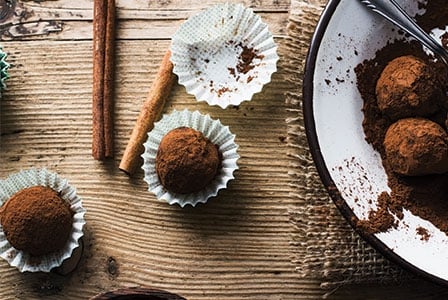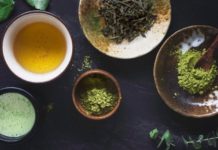
We all love it, but how healthy is chocolate, really? We explore the health pros and cons of this delicious treat.
Chocolate has been called the food of the gods, though we tend to think of it more as the food of love, especially around Valentine’s Day, when fancy boxes of chocolate confections are freely exchanged as tokens of our affection. But just how much do you know about this velvety treat?
Why do we love chocolate?
Chocolate is the most popular candy on earth, comprising nearly 50 percent of global confectionery sales. Aside from the fact that it tastes good, chocolate also makes you feel good—or at least better than before you took that bite.
There’s a reason for that. Scientists who have studied chocolate have been able to isolate more than 300 known chemicals in its makeup, and a combination of some of them may explain the pleasurable effects consuming chocolate has on us.
Caffeine is the best-known ingredient, though it’s present in chocolate in only small amounts. Theobromine, also a stimulant but a weak one, is present as well, and in combination with caffeine and possibly other substances, this may provide that pleasurable rush—sometimes likened to the feeling of being in love.
Is it really healthy?
Judging by headlines, chocolate is also being touted as a health food—almost. Recent studies have shown that pure, unadulterated chocolate is rich in flavanols, which are active antioxidants that may fight inflammation. There are also early indications that pure chocolate can contribute to cardiovascular health by reducing blood pressure. But all studies done so far are small and emphasize that further research is needed to pinpoint the exact substances that may affect our health.
What is clear is that most of the chocolate we eat as treats is processed, because chocolate in its natural state is very bitter in taste and gritty in texture. That processing begins with fermentation of the fresh beans and ends with a complex series of processes (cleaning, roasting, grinding, conching, and tempering) required to produce the rich and meltingly luscious delicacy we enjoy. So, yes, fresh chocolate beans are rich in phytonutrients, but the methods used to make them into palatable treats removes a lot of these nutrients.
Join the dark side
Still, some chocolates are better than others. Most studies show that high quality dark chocolate—anything containing 70 percent or more cocoa solids—has far more flavanols than popular mass-market chocolate, which is usually high in noncocoa fats, sugars, and other additives. The key is not to overdo it. Even plain high quality chocolate contains fat and requires sweeteners to make it palatable, so it’s a high-calorie treat.
Opt for organic
As well, searching out certified organic chocolate assures that what you’re getting is a clean product. Organic chocolate is a relatively new addition to the candy shelf, and although chocolate consumption is growing throughout the world, certified organic production is still only a small fraction of the world’s supply. Mass-market chocolate may be loaded with pesticides.
It’s one of the reasons Joanne Mogridge, co-owner with her husband of a specialty chocolatier on BC’s west coast, uses only organic chocolate to make her confections. Mogridge, who opened her shop 12 years ago, says organic chocolate was the only option she ever considered. “Eating healthy matters to me, as does eating organic. Organic chocolate has been the way for me since the very beginning of my business.”
It wasn’t easy to find organic chocolate at first, Mogridge says. “The choice was slim, and it was—and is—expensive, but it mattered to me. All the ingredients that I can get organic are organic—again, because it matters to me.”
Because of her pioneering work in offering organic chocolate, Mogridge was given a 2013 Merit Award by the International Chocolate Awards, which is an independent organization that seeks to recognize excellence in fine chocolate. Mogridge won the award because “we take for granted that things are organic/local/seasonal, but when Joanne started, it really was unusual,” says Eagranie Yuh, author of The Chocolate Tasting Kit (Chronicle Books, 2014) and grand jury member and Canadian event partner of the International Chocolate Awards.
Bottom line: chocolate is a treat that should be enjoyed, and it’s best in organic form. But don’t fool yourself that you’re eating a health food. Use moderation and go to the dark side whenever you can.
Ethical chocolate
Consumers who want their chocolate clean in both content and production methods should look for the following descriptors when buying.
Fair trade
Most cacao—the name for the beans that eventually become chocolate—is grown on small family farms where the farmer is vulnerable to unpredictable elements such as weather, pests and disease, and unstable markets. Fair trade, which functions under a number of banners, puts producers and consumers into direct partnership to provide better deals and improved terms of trade for the farmer.
CocoaAction
The World Cocoa Foundation initiated this strategy to bring together governments, cacao farmers, and the chocolate industry in support of education, child labour monitoring, and environmental protection for some 300,000 cacao farmers and their communities. The initial strategy will be focused on Côte d’Ivoire and Ghana, the largest cocoa-producing countries in the world, and will eventually be extended to other cocoa-producing countries.
Organic
Organic chocolate came into its own when Bonnat, a highly regarded French chocolate maker, went organic in 1993 as an “ethical choice.” Some 80 percent of the world’s cacao plantations are thought to be de facto organic, because the farmers can’t afford chemical fertilizers or pesticides. But they also can’t afford the complex certification process, so only a tiny fraction of world chocolate production is certified organic, hence the extra cost of buying such chocolate.
Tasty chocolate tidbits
- Theobroma cacao (Greek for “food of the gods”), the tree that bears the seeds that eventually become chocolate, is thought to have originated in the Amazon rainforest some 10,000 to 15,000 years ago.
- Chocolate, which had originally been associated with warrior strength and sexual fertility, became a more innocent treat when Dutch chemist Coenraad Johannes van Houten invented a press in 1828 to separate cocoa butter from cocoa powder, which was used to make a drink even babies could consume, thus setting the stage for the candy industry to come.
- The world’s finest chocolate strains all hail primarily from Central and South America, where cacao beans were used as a form of currency by both Mayan and Aztec societies.
- Richard Cadbury created the first box in which to gift his chocolate in 1868.
- In 1879, Swiss Rudolph Lindt invented the technique of conching chocolate, which created the lusciously smooth and refined chocolate we all crave today.
- The first chocolate to land on the moon came with the crew of Apollo 15 in 1971.

















